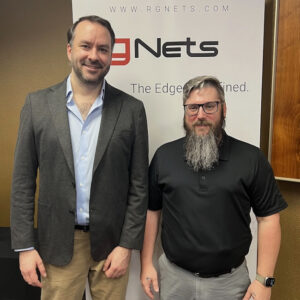|
|
 Clint Kennedy and Alek Murray of RG Nets Presented at Networking Field Day 33 |
This Presentation date is October 25, 2023 at 14:00-15:30.
Presenters: Alek Murray, Clint Kennedy
Follow on Twitter using the following hashtags or usernames: #NFD33
RG Nets rXg Multi-Services Edge Gateway Overview
Watch on YouTube
Watch on Vimeo
The RG Nets rXg is a sophisticated multi-services edge gateway. It provides everything from routing to secure NAC to virtual broadband gateways, and so many services in-between. See an overview of the platform in this video.
Clint Kennedy from RG Nets presented an overview of the rXg Multi-Services Edge Gateway at Networking Field Day 33. RG Nets, a company founded by network engineers, has been profitable for 16 years without VC backing and has about 8,000 global deployments. Their rXg platform integrates multiple network services into a single system, simplifying deployment and management. This solution is suitable for various verticals, including large public venues, hospitality, education, and service providers.
The rXg platform consolidates services like routing, DNS, DHCP, network access control, subscriber management, and more into one operating system, reducing the need for multiple specialized devices. This integration enables easier scaling and deployment, especially in demanding environments like large airports, stadiums, and higher education institutions.
Kennedy emphasized the platform’s API-driven architecture, role-based access control, and clustering capabilities, which allow for high availability and scalability. The platform supports both symmetric and asymmetric clustering, enabling horizontal and vertical scaling. Additionally, RG Nets offers robust management, data plane, and control plane separation, ensuring efficient traffic handling and service delivery.
The presentation also highlighted the platform’s ability to handle complex scenarios like space-time triggers for location-based services, UPnP with CGNAT, and fair share queuing algorithms for bandwidth management. Kennedy assured that the platform’s updates could be managed with minimal disruption, maintaining data plane traffic during upgrades.
Personnel: Clint Kennedy
RG Nets rXg on the Control Plane with Clint Kennedy
Watch on YouTube
Watch on Vimeo
The RG Nets rXg automates myriad access and subscriber services, including NAC with multiple PSK & 802.1X authentication, subscriber self service and provisioning, PMS and billing integration, LBS, NAT and more. Complex subscriber services can be configured and delivered by non-IT staff through intuitive portals.
In the presentation by Clint Kennedy and Alek Murray from RG Nets at Networking Field Day 33, the focus was on the control plane functionalities of their rXg platform. The rXg is designed to automate a wide array of access and subscriber services, such as network access control (NAC) with multiple pre-shared keys (PSK) and 802.1X authentication, subscriber self-service and provisioning, integration with property management systems (PMS) and billing, as well as location-based services (LBS). The control plane handles clustering and subscriber provisioning, allowing non-technical staff to manage complex subscriber services through intuitive portals. The platform supports both data and management planes, which will be discussed in future sessions.
One of the key features demonstrated was subscriber self-provisioning, where users can connect to the network, select billing plans, and manage their own credentials. This is particularly useful in environments such as hotels, multi-dwelling units (MDUs), convention centers, and airports. The system also supports sponsored guest workflows, allowing enterprise networks to manage guest access efficiently. The front office manager interface simplifies network management for non-technical staff, enabling them to perform tasks such as reconnecting rooms, changing billing plans, and providing refunds. Additionally, the conference portal allows event planners to manage wired and wireless infrastructure dynamically, including creating SSIDs and configuring network settings on demand.
The presentation also highlighted the flexibility and security of the rXg platform, which supports multiple pre-shared keys and 802.1X authentication with full LDAP and RADIUS integration. This allows for secure network access even for devices that do not support 802.1X. The platform’s integration with property management systems enables seamless connectivity for users based on room numbers or loyalty numbers, reducing the need for IT intervention. Enhanced location-based services provide real-time mapping and tracking capabilities, useful in large venues like malls or hospitals. The platform’s ability to manage various vendor equipment through APIs, SNMP, and shell commands further underscores its versatility and robustness in handling diverse networking environments.
Personnel: Alek Murray, Clint Kennedy
RG Nets rXg on the Data Plane
Watch on YouTube
Watch on Vimeo
The RG Nets rXg automates important network data plane operations to ensure a secure, high-performance network experience for all users; micro-segmentation by user, class or device type, traffic shaping and airtime equalization, DHCP/DNS, content filtering, more.
RG Nets’ rXg platform is designed to simplify and automate complex network operations, ensuring a secure and high-performance experience for users. By leveraging multiple pre-shared keys (PSK) along with 802.1X and captive portals, rXg reduces the need for multiple SSIDs, streamlining network management. This system enables micro-segmentation by dynamically assigning VLANs and subnets based on user identity, device type, or group, which allows for efficient policy enforcement, such as bandwidth allocation and device limits. This approach makes it possible to manage various environments like hotels, student housing, and office buildings with ease, ensuring each user or device is placed in its own layer 2 and layer 3 boundary, facilitating seamless device discovery and connectivity.
The platform’s capability to dynamically build and manage VLANs, subnets, and DHCP scopes significantly reduces the time and effort required to configure network policies. By automating these processes, RG Nets’ rXg can scale from single-site deployments to large-scale multi-site networks, maintaining consistent policy enforcement across different manufacturers’ equipment. This flexibility is particularly beneficial in mixed environments, where supply chain issues may necessitate the use of different vendors’ hardware. The system’s template-based configuration ensures that policies are uniformly applied, regardless of the underlying hardware, simplifying network management and reducing the potential for configuration errors.
Moreover, RG Nets’ rXg addresses common challenges in network management, such as multicast DNS (mDNS) issues in segmented networks, by ensuring that devices within the same VLAN can discover each other without additional configuration. The platform also features advanced traffic shaping capabilities, dynamically adjusting bandwidth allocation based on real-time usage to prevent network congestion and ensure a fair distribution of resources. This is particularly useful in environments with high bandwidth demands, such as gaming or streaming, where it can prevent individual users from monopolizing the connection. Additionally, rXg supports various tunneling and VLAN extension techniques, such as Q-in-Q and SPB, to overcome the limitations of traditional VLANs, further enhancing its scalability and flexibility.
Personnel: Alek Murray, Clint Kennedy
RG Nets rXg on the Management Plane
Watch on YouTube
Watch on Vimeo
The RG Nets rXg provides important management functionality for network operators, including multi-vendor wired/wireless infrastructure management, comprehensive reporting and log retention, no/low touch provisioning, multi-site management.
In the presentation at Networking Field Day 33, RG Nets showcased their rXg platform’s extensive management capabilities for network operators, emphasizing its multi-vendor wired and wireless infrastructure management. Clint Kennedy and Alek Murray highlighted the platform’s ability to take command and control of third-party systems, offering features such as template configurations and a built-in hypervisor for rapid deployment. The system can automatically discover neighboring devices using protocols like LDP and CDP, creating customizable network maps that show link statuses and VLAN associations. This comprehensive management extends to both wired and wireless networks, allowing for unified policy application across different types of infrastructure.
The rXg platform also excels in reporting and log retention, offering customizable log rotation periods and priority levels to ensure essential data is preserved even when storage capacity is limited. Logs can be offloaded to external servers, and the system supports hardware upgrades or deployment on customer-provided hardware for extended log retention. Zero and low-touch provisioning features significantly simplify device setup and deployment, reducing the time and manpower required for network installations. The platform supports both zero-touch provisioning (ZTP) and a one-touch provisioning method for devices that do not support ZTP, facilitating quick and efficient network configurations.
Fleet Manager, a key component of the rXg platform, enables centralized management of multiple remote sites, including software updates, configuration templates, and ZTP deployments. It consolidates reports from various sites and supports multi-tenancy, allowing different customers to access specific groups of sites with role-based access control (RBAC). The system also includes a Bastion Host feature for secure, certificate-encrypted traffic tunnels between remote sites and Fleet Manager. This comprehensive suite of tools ensures that network operators can manage complex, multi-site deployments with ease, maintaining high levels of security and operational efficiency.
Personnel: Alek Murray, Clint Kennedy








